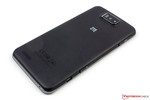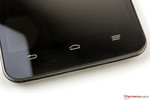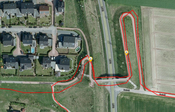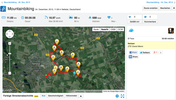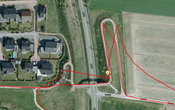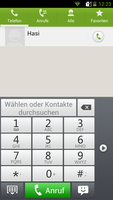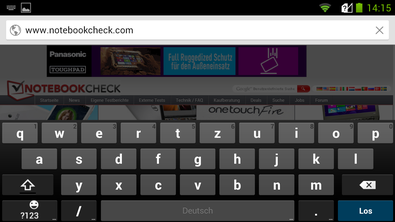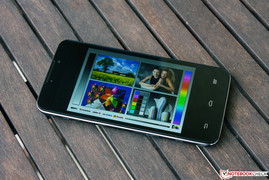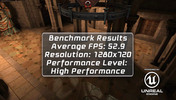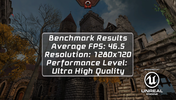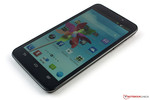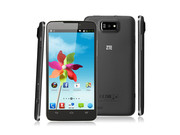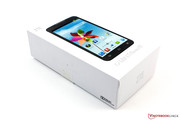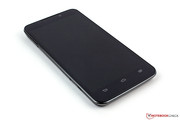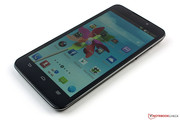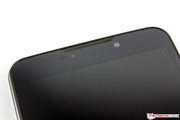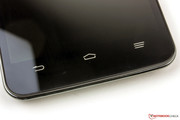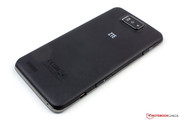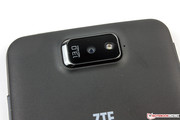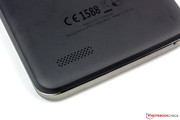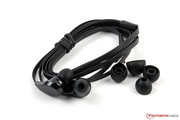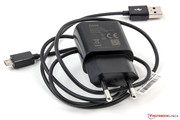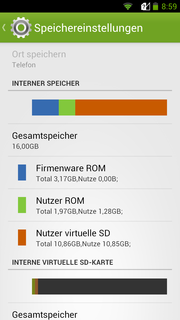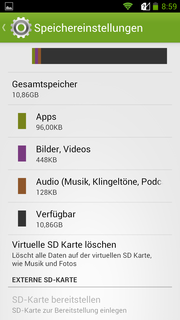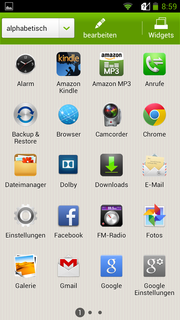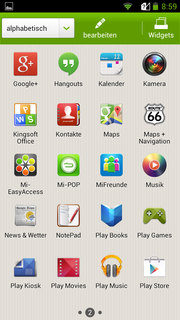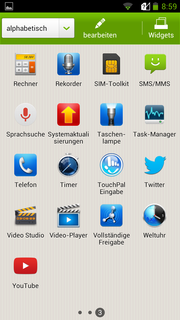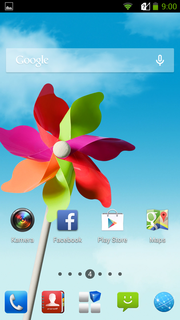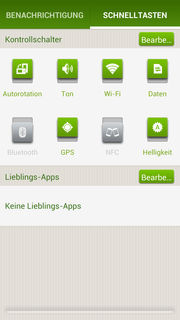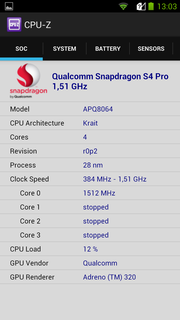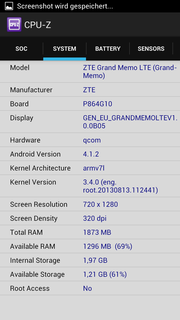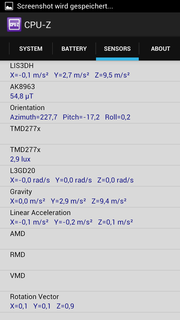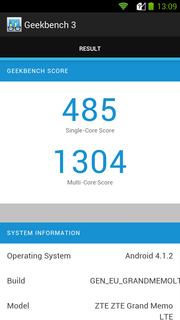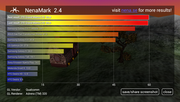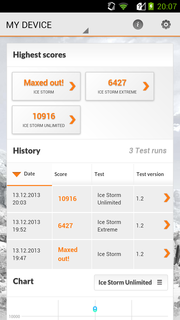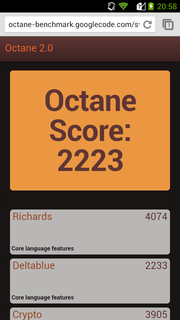Review ZTE Grand Memo LTE Smartphone

For the original German review, see here.
Big smartphones and phablets are in fashion. The Chinese manufacturer ZTE presented its XL smartphone Grand Memo back in February at the Mobile World Congress (MWC). Since October the 5.7-inch device has been available in Europe and has finally found its way into our hands. Unlike the Chinese version, however, the European sister model is not fitted with a Snapdragon 800 processor but a slightly weaker model. With the Qualcomm Snapdragon S4 Pro the Grand Memo has nonetheless plenty of mobile computing power. The RRP of 399 Euros (~$545) has already been undercut.
The competitors are as big as prestigious. Samsung offers in the mid-range the Galaxy Mega 6.3 (from 309 Euros up, ~$422) as well as the Note 2 (without LTE, from 378 Euros up, ~$516). The Asus Fonepad FHD 6 (from 332 Euros up, ~$453) and the Huawei Ascend Mate (from 269 Euros up, ~$367) are also direct competitors. In addition, the upcoming Nokia Lumia 1320 (399 Euros, ~$545) is also among the buyer's options as the single non-Asian product.
The ZTE Grand Memo measures 158 x 82 x 8.9 millimeters and weighs 197 grams. Therefore it is comparatively slim, which is also attributed to the fact that it has one of the smallest panels in the comparison field. Only the Samsung Galaxy Note 2 (5.55-inches, 182 g) has a slightly smaller display and weighs somewhat less.
The display cover is not made of scratch-proof glass and is cased with a black plastic frame. Between the back cover and the screen is a metallic colored frame, which gives the device a more valuable look. The camera at the back side protrudes significantly. The clearances are consistent and no cause for criticism.
Although the covers of the card slots can be opened very easily, they seal them reliably. The torsional rigidity of the smartphone is quite adequate. Only under great pressure the smartphone bends slightly causing it to make a creaking sound. The pressure sensitivity is not as convincing. While the back side is impervious, corrugation on the panel can be caused by holding the Grand Memo tightly at the display edges. Little pressure at the upper screen edge also makes the backlight visible.
Unfortunately the battery of the device is permanently installed and cannot be exchanged.
The connectivity of the ZTE Grand Memo contains no surprises. The data exchange is realized via the Micro-USB 2.0 connection through which the smartphone is also charged. MHL is not supported, however, connecting a USB stick and a mouse works without any problems.
The integrated MicroSD card slot supports memory cards with a size of up to 32 GB (SDHC). A support of the more modern SDXC standard would have been desirable. DLNA and NFC are on board.
Software
As operating system the Grand Memo ZTE deploys Google's Android 4.1.2 Jelly Bean. Hence the device does not come with an up-to-date version of the mobile OS. The surface is prettied up by the manufacturer's own user interface (UI) whose adjustments are, however, limited to the looks.
Unfortunately, we find numerous preinstalled apps without actual additional value (bloatware) on the system. However, they can be removed easily.
Communication & GPS
The communication features of the ZTE Grand Memo LTE are quite impressive. The WLAN module supports the IEEE 802.11 standards b/g/n and hence radios in the frequency range with 2.4 GHz. Other websites mention at this point a dual band component. However, this is neither in accord with the specifications of the manufacturer nor was the smartphone able to connect to a router (Fritz!Box 6360) when it exclusively operated in the 5 GHz range. The operating range of the module is merely average. At 15 m from the router the connection was already very weak. Websites, though, could still be called up with a short delay. Bluetooth 4.0 and NFC are also on board.
The WWAN modem supports tri-band GSM. The slightly poor frequency coverage is continued for the UMTS/HSPA frequencies. Only the frequency bands with 900 and 2,100 MHz are supported which admittedly allows a reception in every network but causes losses in quality. Nevertheless ZTE indicates possible download rates of up to 41 MBit/s which will hardly be possible in reality, however. The faster data standard LTE can also be used but once again minor drawbacks have to be accepted. In the Grand Memo not the most current standard is deployed hence the maximum data exchange rate is limited to 100 MBit/s.
The GPS receiver, however, works quite well. In buildings our position is determined in less than 30 seconds. Outside it works even faster. It handles the comparison with the professional navigation device Garmin Edge 500 quite well. Although the route tracking is not quite as exact it is still at an expedient level.
Telephone Function and Speech Quality
The telephone app in the ZTE Grand Memo is clearly designed. It is very pleasant that the numeric pad can be moved slightly to the left or right which allows controlling the device with only one hand despite its vast display diagonal.
The speech quality cannot convince us. When the device is held up to the ear as well as when the speaker is activated we were understood very quietly at first and became louder after a few seconds. Nevertheless the caller sounds quite noisy and faint via the Grand Memo. Although we were able to understand our interlocutor he, too, sounded rather dull. When high sounds were added they sounded almost jarring and hurt the ears. Background noises were not filtered out at all. Via the accompanying headset we were even more difficult to understand. The proximity sensor works somewhat sluggishly but still reliably.
Cameras & Multimedia
The ZTE Grand Memo LTE comes with a front side webcam, which has a resolution of 0.9 MP (1280x720 pixels). It only suffices for video telephony under good lighting conditions.
The main camera is significantly better and has a 13 MP sensor (4096x3072 pixels). Additionally the lens is equipped with a flash as well as an autofocus. Hence this leads to comparatively good results. Although it does not quite suffice to draw level with the camera from top devices, like the iPhone 5 or the Lumia 1020, the pictures are quite sharp. The colors could be a little more vivid and the sensor struggles with even the slightest front-lighting when taking pictures under ambient light. Nonetheless the camera of the Grand Memo is quite suitable for snap-shots and convincing given its price.
Accessories
The amount of accessories provided in the scope of delivery of the ZTE Grand Memo is rather limited. Besides the modular power supply with a nominal capacity of 7.5 watts (5 volts, 1.5 amperes) it also contains the respective USB cable. This can be used for charging the smartphone as well as data transfer at a computer. In addition to that the manufacturer includes a headset and a multilingual quick-start guide.
ZTE does not offer special optional accessories for the device. However, the usual accessories like headphones, cases and screen protectors can be obtained from third-party manufacturers.
Warranty
ZTE grants a 24-month warranty for the Grand Memo. The battery's and the power supply's warranty lasts six months. A warranty extension is not possible for private customers.
Input Devices & Control
The 5.7-inch capacitive touchscreen of the ZTE Grand Memo recognizes up to ten simultaneous touches and has good gliding qualities. Even at the periphery of the panel inputs are impeccably recognized and quickly converted.
For the virtual keyboard ZTE refrained from adjustments and relies on the standard layout of Google Android. Since the display is very big it even offers enough space for the keyboard in portrait mode and only requires one third of the content to do so. In landscape mode the keys get considerably wider and can be read without any problems. However, the input surface claims almost half of the display.
The automatic screen rotation reacts quickly and needs less than two seconds to acquire its new position.
The ZTE Grand Memo has a 5.7-inch IPS display with a resolution of 1280x720 pixels. This correlates to an aspect ratio of 16:9 and a pixel density of 258 PPI. Hence ZTE, just like many other manufacturers, does not deploy a Full HD panel although it would be very sensible for such big display diagonals. The picture is, nonetheless, sharp and crystal-clear. A stair effect is not visible to the naked eye. The panel of the Asus Fonepad 6 (1080p) is the only one among the competition that has a higher resolution.
The brightness of the panel is with an average of 418 cd/m², very good and with 95% brightness distribution extremely evenly distributed at that. The displays in the Galaxy Mega (444 cd/m², 90%), Fonepad 6 (461 cd/m², 88%) and Ascend Mate (471 cd/m², 89%) are admittedly slightly brighter but as regards illumination not one is as good as the test sample. We did not detect any halos.
| |||||||||||||||||||||||||
Brightness Distribution: 95 %
Center on Battery: 422 cd/m²
Contrast: 1055:1 (Black: 0.4 cd/m²)
ΔE Color 7.46 | 0.5-29.43 Ø5
ΔE Greyscale 8.98 | 0.57-98 Ø5.3
Gamma: 2.14
With a contrast ratio of 1055:1 and a black value of 0.4 cd/m² the ZTE Grand Memo achieves really good measured values given the used display technology and the high brightness. Subjectively speaking the vivid colors and the deep black are convincing whereby the smartphone reinforces its aspiration as a multimedia device. Only the Galaxy Note 2 (AMOLED panel) achieved even better results.
Concerning color accuracy the smartphone does not come off as well. Especially at the white values our measurements yielded a dE of 10 or higher. This leads to a slight green cast which does not strike attention during everyday use, however. The grayscale displays this green cast a little more distinctly. When calibrating the display the Chinese company could have put in a little bit more effort.
Concerning outdoor use the ZTE Grand Memo made a good impression. The high brightness and the rich contrast ensured that even under bright ambient light the display remained easy to read. However, the device still struggles with light reflections due to its reflective surface. Hence using the device under direct sunlight is hardly possible.
The viewing angle stability of the ZTE Grand Memo is very good. Due to the implemented IPS technology the picture remains stable and shows no deviations even at especially acute viewing angles. Merely the brightness of the panel lessens slightly at an inclination of about 30 degrees. Under bright ambient light the reflective surface might pose another problem.
For the processor the ZTE Grand Memo relies on a Qualcomm Snapdragon S4 Pro APQ8064. It has four cores at its disposal which clock with up to 1.5 GHz. Additionally it is supported by 2 GB main memory and the graphics unit Adreno 320. This gives the smartphone a powerful performance basis that should outperform the competition in the majority of cases.
In the benchmark Passmark, however, it performs partly worse than the competitors. Especially concerning RAM and flash memory the test sample is equipped with rather slow components. The performance of the processor is nonetheless very good and outshines the competition in Linpack and the physics computations of 3DMark. Here, only the Atom processor of the Fonepad 6 can keep up despite the fact that it has two cores less at its command.
| AnTuTu v4 - Total Score (sort by value) | |
| ZTE Grand Memo LTE | |
| Asus Fonepad Note FHD 6 ME560CG (K00G) | |
| 3DMark | |
| 1920x1080 Ice Storm Extreme Score (sort by value) | |
| ZTE Grand Memo LTE | |
| Huawei Ascend Mate | |
| Asus Fonepad Note FHD 6 ME560CG (K00G) | |
| HTC Butterfly | |
| 1920x1080 Ice Storm Extreme Graphics (sort by value) | |
| ZTE Grand Memo LTE | |
| Huawei Ascend Mate | |
| Asus Fonepad Note FHD 6 ME560CG (K00G) | |
| HTC Butterfly | |
| 1920x1080 Ice Storm Extreme Physics (sort by value) | |
| ZTE Grand Memo LTE | |
| Huawei Ascend Mate | |
| Asus Fonepad Note FHD 6 ME560CG (K00G) | |
| HTC Butterfly | |
| GFXBench (DX / GLBenchmark) 2.7 | |
| T-Rex Onscreen (sort by value) | |
| ZTE Grand Memo LTE | |
| Huawei Ascend Mate | |
| Asus Fonepad Note FHD 6 ME560CG (K00G) | |
| Samsung Galaxy Mega 6.3 I9200 | |
| HTC Butterfly | |
| 1920x1080 T-Rex Offscreen (sort by value) | |
| ZTE Grand Memo LTE | |
| Huawei Ascend Mate | |
| Asus Fonepad Note FHD 6 ME560CG (K00G) | |
| Samsung Galaxy Mega 6.3 I9200 | |
| HTC Butterfly | |
Despite the more modern browser (Google Chrome 31) the ZTE Grand Memo is unable to dominate in any of the benchmarks. Especially in Sunspider 1.0 the competition is partly significantly superior. Even the HTC Butterfly, which has the identical SoC, is faster. In Google's Octane benchmark, however, only the Asus Fonepad is better. Once again the slower memory could be throttling the performance. Subjectively speaking there is nothing to complain about the browsing qualities of the Grand Memo though.
| Peacekeeper - --- (sort by value) | |
| ZTE Grand Memo LTE | |
| Huawei Ascend Mate | |
| Samsung Galaxy Mega 6.3 I9200 | |
| Asus Fonepad Note FHD 6 ME560CG (K00G) | |
| Sunspider - 1.0 Total Score (sort by value) | |
| ZTE Grand Memo LTE | |
| Huawei Ascend Mate | |
| Samsung Galaxy Mega 6.3 I9200 | |
| HTC Butterfly | |
| Asus Fonepad Note FHD 6 ME560CG (K00G) | |
| Octane V1 - Total Score (sort by value) | |
| ZTE Grand Memo LTE | |
| Huawei Ascend Mate | |
| Samsung Galaxy Mega 6.3 I9200 | |
| HTC Butterfly | |
| Asus Fonepad Note FHD 6 ME560CG (K00G) | |
| Browsermark - --- (sort by value) | |
| ZTE Grand Memo LTE | |
| HTC Butterfly | |
| Asus Fonepad Note FHD 6 ME560CG (K00G) | |
* ... smaller is better
The flash memory of the ZTE Grand Memo is 16 GB in size. After the initial boot of the smartphone almost 11 GB is left for the user's purposes. In AndroBench the memory presents itself somewhat quicker than in Passmark and is able to outperform most of its competitors. Especially the reading of data is completed comparatively quickly by the device. Here, only the Fonepad Note 6 is somewhat faster. For the writing of small data blocks (4k) it is even undisputed in comparison.
Games
With the graphics unit Adreno 320 from Qualcomm the ZTE Grand Memo is equipped with a powerful GPU. It is only minimally slower than the current model Adreno 330 and already supports OpenGL ES 3.0. Therefore it should be able to handle future games as well.
The performance of the GPU suffices easily for all games in the Play Store. No matter if it is a current 3D hit or a classic game the Grand Memo is able to deal with any task. The good touchscreen and the reliably working sensors add to the unlimited fun.
Temperature
The surface temperatures of the ZTE Grand Memo during idle mode reach a maximum value of 30.4 °C and are therefore within an absolutely harmless range.
Under load, however, the temperatures rise heavily and reach a maximum value of 44.9 °C. Among the competition only the Huawei Ascend Mate (max. 47.8 °C) gets even warmer. The test sample gets hottest in the area of the earpiece. This value, however, was determined with the app Stability Test which has a runtime of at least one hour. Hence this situation will only rarely occur during everyday use.
(±) The maximum temperature on the upper side is 42.5 °C / 109 F, compared to the average of 35 °C / 95 F, ranging from 21.9 to 56 °C for the class Smartphone.
(±) The bottom heats up to a maximum of 44.9 °C / 113 F, compared to the average of 33.8 °C / 93 F
(+) In idle usage, the average temperature for the upper side is 29.1 °C / 84 F, compared to the device average of 32.7 °C / 91 F.
Speakers
The mono speaker installed in the back side does its job surprisingly well. The best sound results are achieved when the ZTE Grand Memo is placed with the display side on the table or held in one hand. Especially the highs are then very clear. The bass is subtle but audible while the mids are thin. Only at high volumes does the sound become somewhat tinny. When the speaker is also covered the tones seem dull.
The sound output via the 3.5 mm stereo jack works fine. The accompanying headphones were not able to convince us in this scenario once again. They are extremely bass-heavy and the highs sound hollow and resonate.
Power Consumption
During idle mode the power consumption of the ZTE Grand Memo ranges between 0.6 and 2.4 watts and is therefore at a comparatively good level. The Samsung Galaxy Mega (0.6 - 1.8 W), however, is even more frugal despite its bigger display.
Under load the consumption values rise to up to 7.1 watts. This is ascertained via the app Stability Test (CPU + GPU). This time the consumption value lies slightly above those of the remaining rivals which, given the more powerful SoC, comes as not much of a surprise. The Ascend Mate has higher power consumption and requires up to 10.7 watts. Considering the maximum consumption of our test sample the power supply (7.5 W) seems a little scarcely dimensioned. This also became partly apparent in the benchmarks when the battery was discharged minimally.
| Off / Standby | |
| Idle | |
| Load |
|
Battery Runtime
The permanently mounted energy storage of the ZTE Grand Memo LTE provides 3,200 mAh. Hence it is rather well-dimensioned and promises good runtimes.
We ascertained the maximum runtime at the lowest display brightness and, apart from WLAN, all communication modules deactivated. We simultaneously simulated reading a book via a browser script. Only after more than 21 hours did the battery quit. A very respectable result.
In the reverse scenario we try to exhaust the battery as quickly as possible. To do so the panel is set to maximum brightness and all consumers activated. With the app Stability Test both CPU and GPU are loaded equally. The smartphone lasted 3 hours and 48 minutes.
A surprise was that the Grand Memo had to be plugged in again half an hour earlier when playing back a Full HD video. Even though this time all consumers were deactivated and the display set to 150 cd/m². Repeating both tests did not change the results.
The browsing via WLAN test is more practically oriented. The screen is once more set to 150 cd/m² and all radio modules except WLAN deactivated. Then websites are called up every 40 seconds via a browser script. Once again the Grand Memo achieves a very good value of considerably more than 18 hours.
All in all, the test sample can convince us. Only during video playback would we have wished for a somewhat better result.
Verdict
With the ZTE Grand Memo LTE the Chinese company offers an interesting XL smartphone whose greatest feature is its great display. Concerning workmanship, especially the touch sensitivity of the panel frame and the cover of the slots are annoying. The latter do not create the impression that they are built to last.
It is pleasant that LTE is included. Unfortunately the remaining radio standards were neglected. No Quad-GSM and very poor frequency coverage in the HSPA range are disappointing, especially since only a small portion of buyers will already use LTE. The WLAN module could also have been a little bit better equipped. The speech quality is unfortunately only moderate.
Nevertheless the Grand Memo has quite a lot to offer for currently 300 Euros (~$409) and is a fair offer. Especially the camera is unbeatable compared to the competition. Those who would rather like to call a Full HD device their own and not go without a stylus should have a closer look at the Asus Fonepad Note 6. Those who require a better network coverage and good speech quality should maybe turn to the Samsung Galaxy Mega 6.3.


 Deutsch
Deutsch English
English Español
Español Français
Français Italiano
Italiano Nederlands
Nederlands Polski
Polski Português
Português Русский
Русский Türkçe
Türkçe Svenska
Svenska Chinese
Chinese Magyar
Magyar
